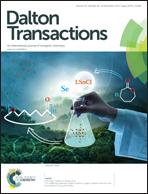Mono- and di-bromo platinum(iv) prodrugs via oxidative bromination: synthesis, characterization, and cytotoxicity†
Abstract
Platinum(IV)-based anticancer prodrugs have attracted much attention due to their relative inertness under physiological conditions, being activated inside cells, and their capacity for functionalization with a variety of small-molecule or macromolecule moieties. Novel asymmetric platinum(IV) compounds synthesized through expedient and unique methods are desired. Here we utilize N-bromosuccinimide (NBS) and carry out oxidative bromination on platinum(II) drugs, namely cisplatin, carboplatin, and oxaliplatin, to obtain asymmetric and mono-bromo platinum(IV) prodrugs. Different solvents are used to obtain various compounds, and the compounds are further functionalized. Di-bromo compounds are also obtained through NBS-directed oxidative bromination in ethanol. The crystal structures of representative compounds are discussed, and the reduction potentials of some compounds are examined. A cytotoxicity test shows that the mono- and di-bromo platinum(IV) compounds are active against human ovarian cancer cells. Our study enriches the family of asymmetric platinum(IV) prodrugs and provides with a convenient strategy to obtain brominated platinum(IV) complexes.


 Please wait while we load your content...
Please wait while we load your content...